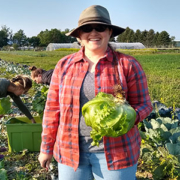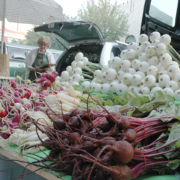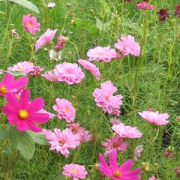Techniques for Selling the Farm Story
 Print This Post
Print This Post
By Daniel Prial, NCAT Community Food Specialist
Spicing Up Your Story
 Let me start by saying that I’m not a graphic designer. I’m a storyteller. But any good storyteller knows that there’s more than one way to tell a story. Some storytellers specialize in audio (e.g., podcasts), others in video (e.g., films). Even C3PO in Star Wars integrated a little bit of audio into his storytelling in Return of the Jedi!
Let me start by saying that I’m not a graphic designer. I’m a storyteller. But any good storyteller knows that there’s more than one way to tell a story. Some storytellers specialize in audio (e.g., podcasts), others in video (e.g., films). Even C3PO in Star Wars integrated a little bit of audio into his storytelling in Return of the Jedi!
As I’ve worked to improve my own storytelling, I’ve kept an eye open to the many ways to spice things up. As a Peace Corps volunteer, I created a radio drama out of my favorite movie, the Princess Bride. As a grad student, I dabbled in film production.
The point of all this exploration was to better understand how to connect a story with its audience.
And, since your farm brand is your farm story, here are some ways that will spice up your farm brand and give you new ways to connect to your customers that you can explore.
Quick Review: Giving Your Products Meaning
If you’ve got the time, take a gander at the blog post Giving Your Products Meaning. But here’s a quick recap:
To successfully tell a story and create meaning, you need to consider three elements:
- Subject – What are you telling? What is the content?
- Audience – Who are you telling the story to?
- Method – How are you going to tell the story?
Meaning comes from connecting your farm business and farm products to intangible ideas, concepts, feelings, values, and more. For example, a pen can be about writing and communicating. Your kale can be about nutrition and health. Your farm can be about traditional family values.
Storytelling Tools
Let’s talk about six different ways to convey the meaning of your farm brand and ways you can learn more:
- The farm name
- The farm mission, vision, and values
- The farm logo
- Labels and certifications
- Fonts
- Colors
The Farm Name
Perhaps more than any other branding tool, the farm name is the most direct way for you to share the farm brand.
Let us look at a couple famous names in farming circles: Polyface Farm and Four Seasons Farm. Just from their names alone, we get a sense that Polyface is going to be a diverse operation. The prefix poly- means “many.” A farm named “many face” suggests that they have many different operations going on. Four Seasons Farm—just from the name alone—tells us that they are likely growing year-round. In other words, they must have figured out how to grow during the winter.
And the names do, in fact, tell the full story. If you don’t know these famous farms, follow the links and have fun learning about them.
Tim Young of Small Farm Nation is a farm-marketing consultant who offers much of his material for free online. He recommends that a farm name should meet nine criteria. Check it out and see how much it applies to your farm business.
Mission, Vision, Values
Mission, vision, and values are key terms in creating your farm business strategy. Often, these three words boil down to a single tagline.
Soul Fire Farm in upstate New York has a powerful tagline: Ending racism and injustice in the food system.
Soul Fire is saying that the products of their farm—the kale, the radishes, the classes, etc.—are all unified by one purpose: an end to injustice. That is the meaning and the story of the farm. Soul Fire Farm has integrated powerful meaning into simple words that are easy for their customers to understand. Their mission, vision, and values, i.e., their reason for being a farm, are clearly and concisely conveyed.
The Farm Logo
The farm logo is a powerful branding tool because it takes us out of the realm of language and into the world of art. Pictures can convey much more meaning than words.
Let’s look at a few examples. The guiding question you should be asking yourself for each logo is: what story is it trying to tell?

Looking at the Echo Farm Puddings logo, ask yourself, what is important to this brand? What would you expect the farmers to be like if you were to meet them? What would you expect the pudding to taste like? What does the artwork suggest to you? What emotional reaction do you have to the logo?
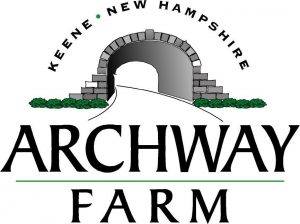
Now, look at the Archway Farm logo, and ask yourself what kind of message it sends. What sense do you get from the farm? What adjectives would you use to describe the farm? The farmer has made a choice here to not clearly define the product the farm produces. How does that open possibilities for the farm business? How does including the farm’s location on the logo affect your thinking about it? What if the logo had included “Established 2015,” or had a tagline? Again, ask yourself what emotional reaction you have to Archway Farm’s logo.
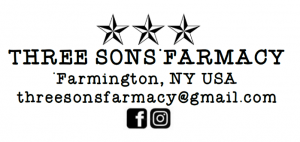
The logo for Three Sons Farmacy is simple: the three stars, the farm name, a location, and contact information. When you look at this logo, what feel do you get for the farm business? What’s important to the owners? What do they value? With logos like this, the font choice does a lot of the conveying of messaging. What does the font choice say to you? Like Archway Farm, Three Sons Farmacy has the location of the farm in the logo. How does that affect your thinking of the farm? How would you use a logo like this on your farm operation?
It is tempting to create your own farm logo, especially when there are so many services available to do so for free or little money. As a general recommendation, however, it is worth hiring a graphic design professional. Graphic designers have the training on how the human brain responds to imagery that is necessary to best convey your farm brand.
It is crucial, however, to provide your graphic designer with your brand identity. Your identity should serve as a guideline to help the designer create something that most accurately represents you and your farm. The closer the designer can come to accurate the first time, the less money you will need to spend on revisions, as most graphic designers charge by the hour.
Labels and Certifications
You can recruit others to tell parts of your farm story. Labels and certifications all carry meaning, as well as rules, guidelines, costs, etc. The classic example of this is the USDA Organic Label. Since the early 2000s, the label has represented that the product adheres to the standards set forward by the USDA National Organic Program. The meaning of the label, as understood by many consumers, however, is that the farm does not use chemicals that are harmful to the environment. It shows that the farm cares about the world around it and that the food someone is about to eat is inherently healthier.
Other examples of labels that carry meaning include:
Fonts
In many ways, fonts are the overlooked champions of brand. They can speak volumes and they are everywhere we look, but people do not often think about font when building up a brand identity.
We can recognize the meanings behind fonts when we hold them next to each other. For example:
![]()
…is very different from…
Get your Pork from Batik Farm
Notice how the former has an old-fashioned feel. It carries a sense of authority and gives the farm a meaning evoking tradition, history, and credibility. The latter is more rounded and is lighter and funkier. It shifts the farm meaning toward fun, youth, and excitement.
The world of fonts is a specialized world and relying on the help of a graphic designer can go a long way toward making your life easier. But the same applies here as with working with a graphic designer on logos: know yourself and your story. Help the graphic designer pick out a few fonts that would work best for you.
Colors
In our society, colors have meaning all on their own. We talk about warm colors and cool colors. People associate red with fire, anger, and danger. Yellow is associated with happiness (the smiley face) and lightness. Green is used to represent life, earth, growth. Blue can be sad, but also calm.
Smashing Magazine did a great online article on color theory and meaning (updated in 2017), but it’s just one of a whole world of resources on color that you can find online.
To test color theory, look at the classic USDA Organic logo. It has a dark, muted green and a lighter accent green, plus a brown circle around it. Green and brown. Can you imagine the same logo in red and yellow?
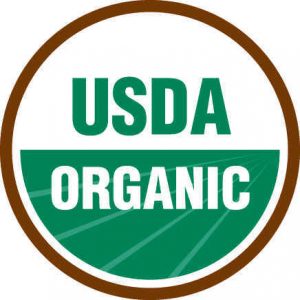
Have Fun with It
Right now, as I write this blog post in New Hampshire, we have a foot of snow on the ground. The goats are in a permanent winter paddock and I don’t need to worry about fencing for another few months. Winter is a great time to play with storytelling.
My best advice for you is to have fun with this. Let yourself get lost in color theory for a while and see how it connects to your farm brand. Dabble with fonts and call up a friend to see what they think. Play around with a logo creator and research graphic designers who understand farm life.
Related ATTRA Resources:
This blog is produced by the National Center for Appropriate Technology through the ATTRA Sustainable Agriculture program, under a cooperative agreement with USDA Rural Development. ATTRA.NCAT.ORG.
All logos used with permission.


